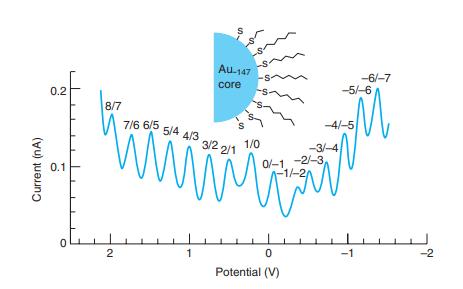Gold nanoparticles (Figure 16-29) can be titrated with the oxidizing agent TCNQ in the presence of excess
Question:
Gold nanoparticles (Figure 16-29) can be titrated with the oxidizing agent TCNQ in the presence of excess of Br to oxidize Au(0) to AuBr in deaerated toluene. Gold atoms in the interior of the particle are Au(0). Gold atoms bound to C12H25S (dodecanethiol) ligands on the surface of the particle are Au(I) and are not titrated.
-1.png)
Reduced TCNQ has a low-energy electronic absorption peak at 856 nm. The table gives the absorbance at 856 nm as 0.700 mL of 1.00×10-4 M TCNQ + 0.05 M (C8H17)4N+Br- in toluene is titrated with gold nanoparticles (1.43 g/L in toluene) from a microsyringe with a Teflon-coated needle. Absorbance in the table has already been corrected for dilution.
-2.png)
(a) Make a graph of absorbance versus volume of titrant and estimate the equivalence point. Calculate the mmol of Au(0) in 1.00 g of nanoparticles.
(b) From other analyses of similarly prepared nanoparticles, it is estimated that 25 wt% of the mass of the particle is dodecanethiol ligand (C12H25S , FM 201.40). Calculate mmol of C12H25S in 1.00 g of nanoparticles.
(c) The Au(I) content of 1.00 g of nanoparticles should be 1.00 mass of Au(0) mass of C12H25S. Calculate the micromoles of Au(I) in 1.00 g of nanoparticles and the mole ratio Au(I):C12H25S. In principle, this ratio should be 1:1. The difference is most likely because C12H25S was not measured for this specific nanoparticle preparation.
Figure 16-29

Step by Step Answer:






